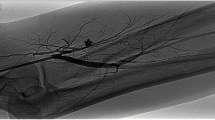Abstract
Current access-preserving treatment options for dialysis-associated steal syndrome (DASS) include fistula lengthening or banding and distal revascularization interval ligation (DRIL). We describe a novel technique for the treatment of DASS that we have termed revision using distal inflow (RUDI). Briefly, the technique involves ligation of the fistula at its origin followed by reestablishment of the fistula via bypass from a more distal arterial source to the venous limb. Four patients with brachial artery-based arteriovenous fistula and DASS underwent RUDI as described above using either the proximal radial or ulnar artery as inflow and vein as conduit. Patients were diagnosed with DASS based on the clinical findings of pain, pallor, loss of radial pulse, and sensorimotor dysfunction after creation of an AVF. Noninvasive vascular studies confirmed diminished finger pressures that improved with compression of the fistula. All patients experienced rapid resolution of their symptoms, although one patient complained of mild residual parasthesias. Follow-up ranging from 4 to 14 months has revealed patent functional fistulas. These initial results demonstrate that RUDI can be an effective treatment of DASS. By design, RUDI incorporates many of the advantages of established access-preserving procedures. That is, by using a smaller distal artery as inflow, RUDI lengthens the fistula, decreases the radius, and preserves antegrade flow in the brachial artery. In contrast to DRIL, it is the fistula, not the native arterial supply, that is placed at risk by ligation and revascularization. Consequently, we believe that RUDI may become the procedure of choice for DASS after brachial artery-based fistulas.

Similar content being viewed by others
References
DeCaprio JD, Valentine RJ, Hakish HB, Awad R, Hagino RT, Clagett GP. Steal syndrome complicating hemodialysis access. Cardiovasc Surg 1997;5:648-653
Morsy AH, Kulbaski M, Chen C, Isiklar H, Lumsden AB. Incidence and characteristics of patients with hand ischemia after a hemodialysis access procedure. J Surg Res 1998;74:8-10
Odland MD, Kelly PH, Ney AL, Anderson RC, Bubrick MP. Management of dialysis-associated steal syndrome complicating upper extremity arteriovenous fistula: use of intraoperative digital photoplethysmography. Surgery 1991;110:664-670
Shemesh D, Mabjeesh NJ, Abramowitz HB. Management of dialysis access-associated steal syndrome: use of intraoperative duplex ultrasound scanning for optimal flow reduction. J Vasc Surg 1999;30:193-195
Wixon CL, Mills JL, Berman SS. Distal revascularization-interval ligation for maintenance of dialysis access and restoration of distal perfusion in ischemic steal syndrome. Semin Vasc Surg 2000;13:77-82
Schanzer H, Eisenberg D. Management of steal syndrome resulting from dialysis access. Semin Vasc Surg 2004;17:45-49
Schanzer H, Schwartz M, Harrington E, Haimov M. Treatment of ischemia due to “steal” by revascularization. J Vasc Surg 1988;7:770-773
Haimov M, Schanzer H, Skladany M. Pathogenesis and management of upper-extremity ischemia following angioaccess surgery. Blood Purif 1996;14:350-354
Schanzer H, Eisenberg D. Management of steal syndrome resulting from dialysis access. Semin Vasc Surg 2004;17:45-49
Bruns SD, Jennings WC. Proximal radial artery as inflow site for native arteriovenous fistula. J Am Coll Surg 2003;197:58-63
Author information
Authors and Affiliations
Corresponding author
About this article
Cite this article
Minion , D.J., Moore, E. & Endean, E. Revision Using Distal Inflow: A Novel Approach to Dialysis-associated Steal Syndrome. Ann Vasc Surg 19, 625–628 (2005). https://doi.org/10.1007/s10016-005-5827-7
Published:
Issue Date:
DOI: https://doi.org/10.1007/s10016-005-5827-7




